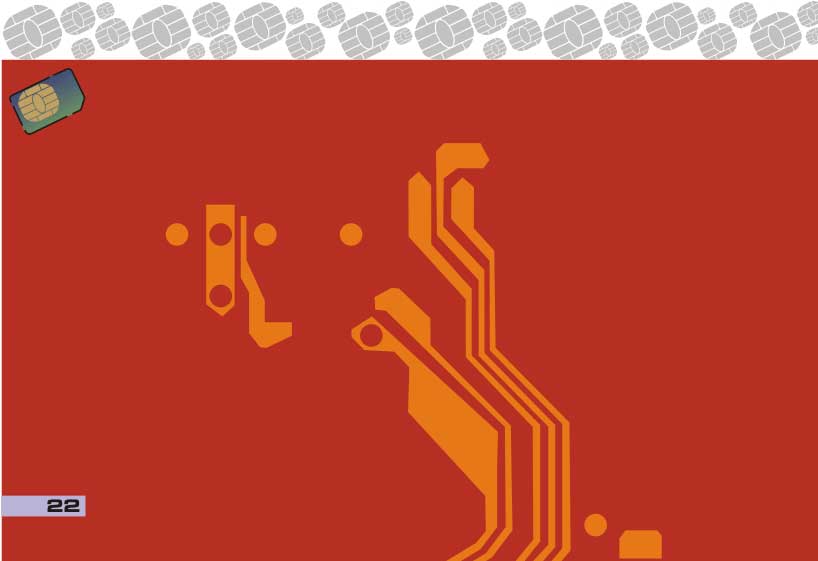



inconvenience. The GSM standard was in the process of development, and the originators offered to differentiate the means of identification of the equipment and the subscribers' functions.
The operation principle of a phone in a GSM network is as follows: the identifier used for the “recognition” of a mobile phone is a 15-digit IMEI (International Mobile Equipment Identifier). This is the number that is assigned to each phone when manufacturing it, while the subscribers are “recognized “ by a SIM (Subscribers Identity Module), which is directly inserted into a phone.
A SIM-card contains the full subscriber-related information required by a GSM network, and its main advantage is the possibility to program it at the very beginning and later sell it as a ready product. A customer can independently insert it in a mobile phone thereby automatically receiving access to a mobile operator. This means that subscribers do not have to visit a mobile operator's office.
Types of SIM-cards and their Capabilities
The most convenient way of making the function of a SIM-card as simple as possible is to use them only to identify subscribers, but the manufacturers have chosen another way, enclosing the authentication and speech encoding functions from the outset. In other words, all of the functions, which are fulfilled by a mobile phone in the networks of other systems are distributed between a phone and a SIM-card in a GSM network; any operation of a purely “connecting” type (transceiving, moduling and identifying signal, emerging and
changing symbols on a phone screen, etc.) is carried out in the phone, while all of the subscriber-related information required by the network is stored on a SIM-card. It is due to such differentiation that any GSM phone can make SOS calls (112, 911, etc) without a SIM-card. Such a requirement was initially enclosed in the standard.
The computing capabilities of a SIM-card may easily be compared with a PC from the 1980s, and the achievements of modern microelectronics allow the constant update and expansion of such capabilities. As a result, SIM-cards can fulfill the function of a phonebook for 250 or more numbers with the names enclosed; it can store the last dialed, received or missed calls; various Java aplets can be loaded in it and much more. Dual-subscription SIM-cards are also available.
SAT (SIM Application Toolkit) technology developed some years ago made revolutionary changes in the history of SIM-cards. The technology is based on the exchanging of information by means of SMS and reveals itself as the special software supplement in the SIM-card. Based on such mini-programs a phone becomes enabled automatically to fulfill a concrete consequence of actions such as calling to a particular number, as well as sending an SMS of particular content, sending e-mail and fax, etc. All these processes may certainly be controlled manually, but automation makes their application much easier and faster.
In other words, the modern SIM-card is a multi-functional, highly technological piece of equipment, and from a purely technical point of view - a variety of the so-called Smart-cards adapted for mobile communications. The parameters of SIM-cards are determined by an ISO 7816 group, and in the process of its development and manufacture most
დაპროგრამებული. ერთი შეხედვით ყველაფერი მარტივად ჩანდა, მაგრამ სწრაფად იმატა მობილური ტელეფონების მწარმოებელთა რიცხვმა... ყოველ მათგანს აპარატების ქარხნული ნომრების თავისი აღნიშვნები ჰქონდა, რამაც მათი ბაზაში მარტივი და ერთგვაროვანი ჩაწერა შეუძლებელი გახადა. ერთი სიტყვით, ტელეფონთან დაკავშირებული ნებისმიერი უმნიშვნელო ოპერაციის ჩასატარებლად, ტელეფონი ფიჭური კავშირგაბმულობის ოპერატორთან უნდა მოხვედრილიყო, რაც, ცხადია, საუკეთესო გამოსავალი ვერ იქნებოდა.
ამ უხერხულობის თავიდან ასაცილებლად, პირველად 90-იანი წლების დასაწყისში, ახალი ევროპული სტანდარტის GSM-ის (რომელიც სწორედ ამ პერიოდში იქმნებოდა და მუშავდებოდა) შემქმნელები დაინტერესდნენ. სწორედ მათ შემოგვთავაზეს მოწყობილობებისა და აბონენტთა ფუნქციების იდენტიფიკაციის საშუალებათა გაყოფა.
GSM სტანდარტის ქსელში ტელეფონის მუშაობის პრინციპი შემდეგგვარია: მობილური ტელეფონის საიდენტიფიკაციოდ გამოიყენება სპეციალური, 15- ციფრიანი უნიკალური ნომერი: IMEI Iნტერნატიონალ Mობილე Eქუიპმენტ Iდენტიფიერ, მობილური მოწყობილობების საერთაშორისო იდენტიფიკატორი. ეს ნომერი ენიჭება ყოველ აპარატს დამზადებისას, ხოლო აბონენტთა იდენტიფიკაციისათვის გამოიყენება სპეციალური ცვლადი მოდული SIM (Subscribe Identity Module), რომელიც უშუალოდ ტელეფონში თავსდება.
სიმ-ბარათი შეიცავს GSM ქსელისათვის საჭირო სრულ ინფორმაციას ამა თუ იმ აბონენტის შესახებ და მისი დადებითი მხარეებიდან ერთ-ერთი
უმთავრესი ისაა, რომ ის შეიძლება თავიდანვე დაპროგრამდეს და შემდგომ გაიყიდოს, როგორც მზა პროდუქტი. მყიდველს შეუძლია დამოუკიდებლად ჩადოს იგი მობილურ ტელეფონში და ავტომატურად ისარგებლოს მობილური კავშირგაბმულობის ოპერატორის მომსახურებით. ყველა ზემოაღნიშნულ შემთხვევაში, ტელეფონისა და სიმ-ბარათის მანიპულირებისას, აბონენტი თავისუფალია კავშირგაბმულობის ოპერატორის ოფისში მისვლისაგან.
სიმ-ბარათის ტიპები და მათი შესაძლებლობები
სიმ-ბარათის ფუნქციის გასამარტივებლად მათი მხოლოდ აბონენტის საიდენტიფიკაციოდ გამოყენება შეიძლებოდა, მაგრამ მწარმოებლები სხვა გზით წავიდნენ და მასში თავიდანვე მისი ნამდვილობის შესამოწმებელი (აუტენტიფიკაციის) და საუბრების შიფრაციის ფუნქციები ჩადეს. სხვგვარად რომ ვთქვათ, ყველა ის ფუნქცია, რომელსაც სხვა სისტემის ქსელებში უშუალოდ მობილური ტელეფონი ასრულებს, GSM ქსელში განაწილებულია ტელეფონსა და სიმ-ბარათს შორის; ყველა წმინდა `დაკავშირების~ ოპერაციები (სიგნალის მიღება-გადაცემა, მისი მოდულირება, ამოცნობა, ტელეფონის ეკრანზე სიმბოლოების გამოჩენა, ცვლა და ა.შ.) ხორციელდება ტელეფონში, ხოლო აბონენტის შესახებ ქსელისთვის აუცილებელი მთელი პერსონალური ინფორმაცია ინახება სიმ-ბარათზე. სწორედ ამ დიფერენციაციის დამსახურებაა ის ფაქტი, რომ ნებისმიერ GSM ტელეფონს სიმ-ბარათის გარეშე შეუძლია SOS ზარების (პოლიცია, სახანძრო,
